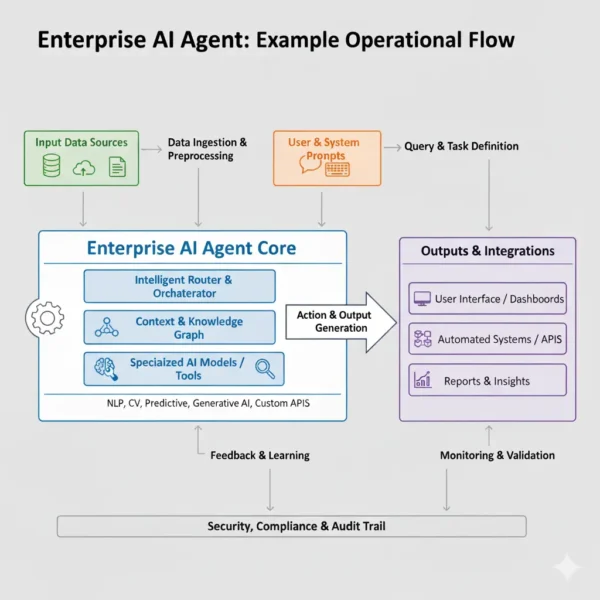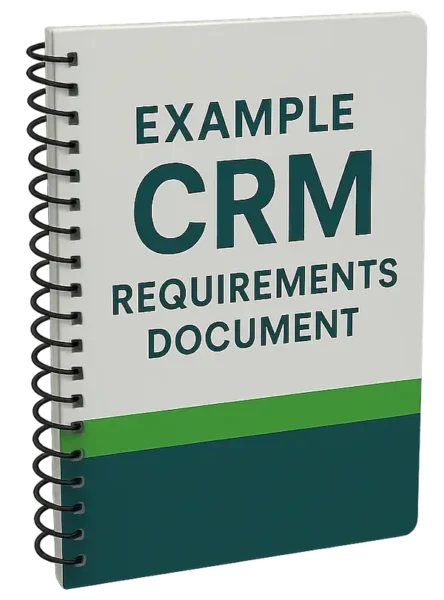As a huge proponent of using AI in business, I’ve spent a lot of time with tools that augment our and our customers’ capabilities.
For marketing initiatives, I have found numerous non-agentic applications for LLMs. So, the concept of enterprise AI Agents—autonomous systems that can do things for you—has been a bit more abstract to me, as it is to many.

To gain some clarity, I sat down with Erin Bebee, the Chief AI Officer of ManoByte, a company actively building and implementing these agents for businesses. One takeaway was this:
A successful AI agent implementation has a lot more in common with a structured CRM implementation than you might think.
Here’s a breakdown of what I learned.
What Exactly is an AI Agent?
When I asked Erin for a simple, prospect-friendly explanation of what an AI agent is, her answer was refreshingly concise.
“The best way to think about AI agents is they are data processors,” she explained.
This definition cuts through the noise. It’s not magic; it’s about designing a path from A to B.
According to Erin, a hurdle is that many people express wanting to ‘solve it all’ in the absence of a clear game plan.
The ground rules for setting up a new AI agent are all about defining the specifics:
- What information is going in?
- What information do you want to come out?
- What is the specific end goal or success metric?
This sounded immediately familiar. It’s analogous to implementing a CRM. A CRM project is far more likely to succeed when a company has its requirements clearly defined before the software is ever switched on. The same principle applies here.
Real-World Use Cases: Moving from ‘What if’ to ‘What is’
So, what business challenges are agents actually solving today? While service departments are currently leading in adoption, Erin noted that sales is an “up-and-coming” area with significant demand.
We discussed a few practical examples:
Automating Sales Quotes
A common request is to generate a quote. An agent can be built to pull data from disparate sources—like a price book in an Excel spreadsheet, a document template, and customer information from the CRM—to assemble and generate a formatted quote.
Deep Account Research
We discussed how an agent could automate the monotonous tasks in enterprise sales. For instance, a rep could ask the agent to research a new account. That agent could also filter an extensive list of contacts from a source like ZoomInfo down to the few key players who actually matter for that specific deal.
Smarter Internal Operations
Erin shared a great internal use case. Their team built an agent that transcribes calls, creates action items, and posts them to Slack. Critically, it doesn’t just summarize; it references the full transcript to pull “deeper meaning” for the tasks. A human then just clicks a button to approve or deny the task creation.
We also touched on the potential in manufacturing companies, where agents could optimize the procurement of raw materials or suggest alternative suppliers if the primary one has an inventory shortage.
The Implementation: Why AI Agents Are Like New Hires
This was my favorite analogy from our conversation. Deploying an AI agent isn’t a ‘set it and forget it’ piece of software; it’s an iterative process.
“It’s a little bit like having a new hire at your company,” Erin said. “There is a transition process into making it actually work. You don’t necessarily hit the nail on the head first try every time.”
Like any new technology, an agent implementation follows a familiar project plan: discovery, requirements, timeline, and go-live. However, Erin emphasized that AI has a longer post-implementation phase. You must check in regularly, fine-tune the outputs, and ensure it’s meeting its goals.
Source Data Quality, Guardrails, and Humans-in-the-Loop
You can’t just unleash an agent and hope for the best. This is where the concept of ‘enterprise-ready’ comes into play.
Garbage In, Garbage Out
An AI’s reliability is 100% dependent on the quality of its input data. Erin shared an anecdote about someone asking ChatGPT how to spell “Oreo” backward.
The AI confidently replied that “Oreo” is a palindrome, citing a single Reddit post as its source. It’s a perfect reminder: you must feed your agents clean, factual information.
The Importance of Guardrails
You must anticipate how an agent could go wrong and establish rules to prevent it. We discussed the story of a car dealership’s chatbot that was tricked into selling a car for $1.
A proper guardrail, like a simple guideline stating, “No selling cars for below X% of list,” would have prevented that. This requires human involvement and training from the start.
The Essential ‘Human Exit Points’
An agent must be aware of its own limitations. “AI likes to think that it can do anything,” Erin noted, “you do need to tell it when it can’t do things.”
For customer service, this is the ‘send me to a real person’ button. For internal agents, it’s a built-in exit point to deflect a request it can’t handle to a human.
My Key Takeaways
My conversation with Erin crystallized how businesses should be thinking about AI agents. They aren’t magic wands. They are powerful tools that, when built correctly, function like dedicated, focused employees.
If you’re considering an AI agent, remember these three things:
- Start with a specific problem, not a vague wish. Define your inputs and desired outputs.
- Treat the implementation like hiring an employee. It requires a plan, a transition period, and an iterative training process.
- Success depends on human oversight. You are responsible for providing high-quality data and setting clear, common-sense guardrails.
A big thank you to Erin of ManoByte for sharing her expertise. It’s clear that AI agents are most powerful when they are implemented with the same business rigor and strategic planning as any other critical enterprise technology.



